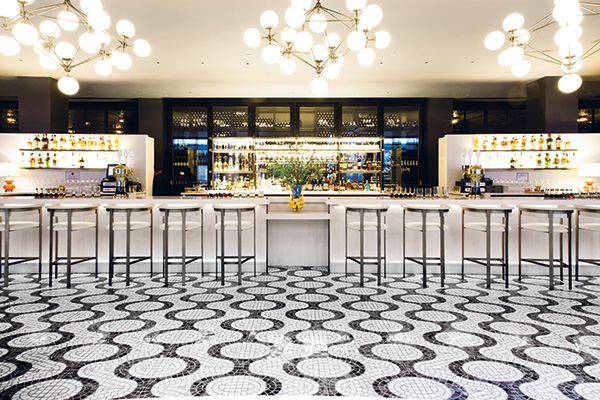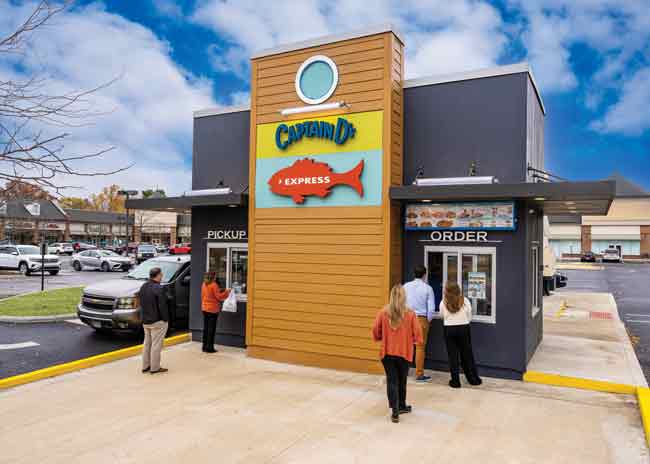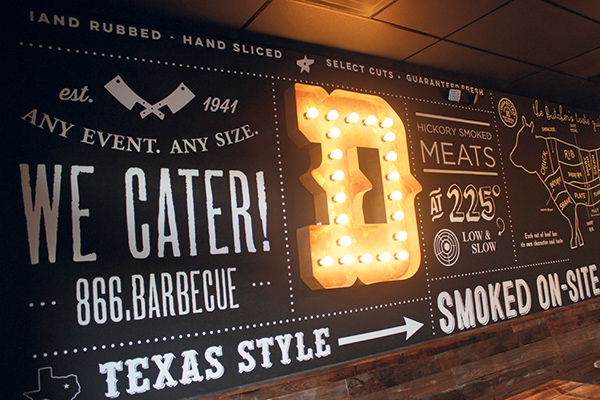Front-of-the-house flooring not only has to look good and complement the interior design, but it should also provide a safe surface for staff and diners.
Flooring material selection for restaurants is often dictated by the overall design aesthetic, type of restaurant, expected foot traffic and location in the establishment.
There are a number of factors to consider that will ensure that both the style and functionality are appropriate for the front of house.
Material Advantages & Disadvantages
The most common materials specified for flooring in commercial dining areas are luxury vinyl tile (LVT), also referred to as luxury vinyl plank (LVP); vinyl composition tile (VCT); rigid core or solid polymer core (SPC); laminate; carpet and carpet tiles; ceramic and porcelain tile; quarry tile; concrete; and hardwood.
The advantages of LVT include longer warranties, ease of maintenance and a better appearance over time due to waterproof properties as well as scuff, scratch and stain resistance. This material is noted for being more comfortable to stand on and quieter under foot than other styles. LVT is available in a variety of styles, colors and textures. Some flooring manufacturers provide extensive customization options. Some drawbacks, depending on manufacturer and project needs, include the material’s impact resistance and recyclability.
Usually thinner than LVT, SPC flooring typically offers planks featuring realistic wood-look designs and includes the additional benefits of being indent resistant and sound absorbing. Unlike hardwood, SPC does not need to be acclimated when installed in a conditioned space, meaning a restaurant can be returned to full operation more quickly after renovation or installation.
Traditional VCT is an economical choice that offers durability over time. This flooring type is available in a wide range of colors. VCT typically requires additional maintenance when compared to LVT or SPC over its lifecycle, as the surface can become irreversibly discolored or delaminated over time. However, coatings are available from some suppliers that reduce initial application of polish and eliminate or reduce ongoing restorative stripping, thereby reducing maintenance over time.
Made from pressed wood, laminate flooring offers added durability, scratch and scuff resistance and can handle wear and tear. However, this material is notorious for being hard, loud and sound reflective. Laminate is not waterproof although it is moisture resistant.
Carpet is less common in commercial restaurants, as it is labor intensive to clean and harbors dust and microbes. In most restaurant settings it is not the most sanitary choice. It does offer comfort under foot, a variety of design options and can help with noise levels by absorbing sound. Traditionally used in lounge or waiting areas where foods are less likely to spill.
Ceramic and porcelain tile floors offer innumerable colors and style options. They can be costly to install and do require routine maintenance, as the grout needs to be deep cleaned periodically. Although this flooring has a very long lifecycle, it is not considered waterproof, since there is the possibility of permeability with these materials. Porcelain is considered more water resistant than ceramic. Impact sounds may be a factor to consider with regard to noise.
Quarry tile is durable, though quality and maintenance requirements vary. These materials are also hard underfoot.
Cement tiles provide long wear and are available in a wide variety of colors and patterns. Cement has a natural feel that provides a good grip, leading to fewer slipping issues when wet. The downside is this is a hard surface that maintains a colder temperature, and there is almost certain breakage with falling glasses and plates. This flooring also requires more attention to detail during installation due to sealing.
Hardwood provides appealing designs and aesthetics, but with the likelihood of spills, moisture and the need for maintenance it can be difficult to maintain in restaurants.
Purchasing Considerations
Restaurant types vary widely, so flooring choices must meet the aesthetic needs of the space while also being durable, easy to clean, and standing up to scratches, scuffs and stains.
Operators should partner with a commercial flooring contractor to ensure that the proper amount of flooring material will be calculated for front-of-house spaces. Contractors will consider factors like the size and shape of the flooring material, if any intricate cuts are desired or necessary, and include some overage material for future repairs. The flooring contractor will also advise on the best installation method and proper subfloor preparation for the space in accordance with the manufacturer’s installation recommendations.
The rule of thumb to determine how much flooring is needed is to order 5 to 10 percent more material than the square footage to be installed to compensate for wastage. The specific amount of wastage for installation depends on the material chosen.
The rule of thumb to determine how much flooring is needed is to order 5 to 10 percent more material than the square footage to be installed to compensate for wastage. The specific amount of wastage for installation depends on the material chosen.
LVT is not recommended for the back of house, but is a solid choice for entryways, hallways and on the dining area floor. In restrooms, LVT works unless there is a floor drain, in which case ceramic or porcelain are recommended. If not, any waterproof or water resistant LVT will work in either a gluedown or floating format. Restaurants are required to use a walk-off mat by the main entrance to the restaurant, from the exterior to the interior, which can be easily laid over LVT.
From a lifecycle cost analysis, consider how long the flooring will last versus both its cost and maintenance. From the standpoint of aesthetics, the look of the floor must appeal to and complement the interior design concept. Maintenance and cleanability are key, along with sanitation, when choosing a flooring type.
Safety from Slipping
Safety regulations vary, depending on the state, but Occupational Safety and Health Administration (OSHA) requires flooring to be slip resistant for workers. To achieve this, a textured floor providing traction is best. The surface should be smooth enough for easy cleaning and be able to handle frequent exposure to cleaning chemicals. Durability is a key component, as front-of-house flooring is exposed to a tremendous amount of abuse. Keep in mind that hard flooring can take a greater toll on waitstaff.
Trends
Hard surface flooring materials for restaurants continue to gain popularity thanks to the wide variety of designs, shapes, sizes, textures and performance levels that can fit in most any budget. Easy maintenance and durability over time provide added value for the restaurant operator.
LVT has been hot in the hospitality industry, especially restaurants, over the last five to seven years. Today’s print technology is more realistic and able to deliver durable, easy-to-maintain flooring that evokes the look of natural materials, such as wood grains, stone and ceramic tile. LVT gives restaurants the look they want at a reasonable price point, in addition to providing the necessary durability and cleanability.
Cement tile’s popularity also is on the rise, due to the bevy of shapes, including hexagons and triangles, as well as expanded color options.
Care & Maintenance Factors
When it comes to care, the flooring manufacturer’s specific maintenance recommendations should be followed. In general, daily sweeping or dust mopping should be conducted for all material types, with routine and periodic maintenance being performed according to the manufacturer recommendations.
Ceramic/porcelain flooring is best cleaned with soap and water and the traditional mop method, with periodic deep cleaning of grout joints; for carpet, vacuuming and steam cleaning as needed will suf fice.
Cement tiles don’t require much maintenance, other than occasional resealing, depending on the application. This averages every 10 years. This flooring can be cleaned using soap and water and waxed for those who prefer a sheen on top. Manufacturers recommend cleaning with a pH neutral, nonacidic cleaner.




